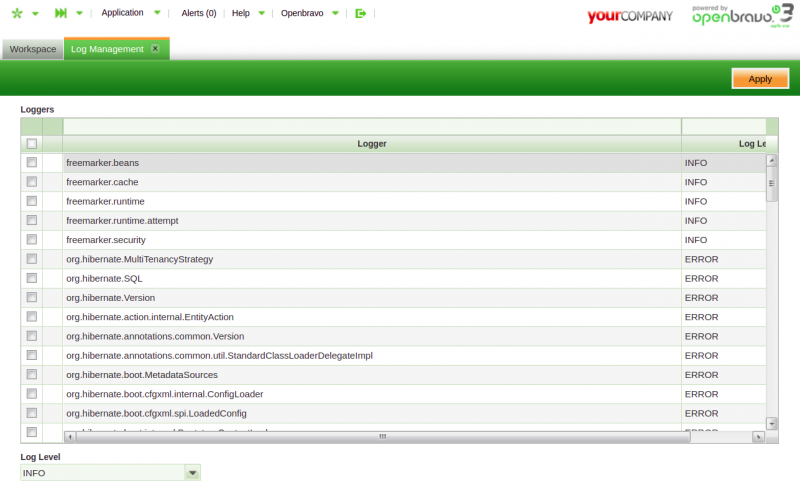How To Configure Log
| log4j2 is introduced in Openbravo since PR19Q1. If you're using a previous version of Openbravo, please refer to How_To_Configure_Log_Using_Log4j1.x to configure log using log4j 1.x. |
Contents
Introduction
Logging allows developers to insert messages when code is executed, these messages can be used to understand different issues in the backend code, such as errors, performance problems, etc.
Starting from PR19Q1, Openbravo uses log4j2 to log.
Configuration
Logging is configured using 3 log configuration files, depending on the scenario:
config/log4j2.xml: Is the configuration for build tasks, both from the command line and the rebuild launched from the Module Management Window.config/log4j2-web.xml: This configuration is used for the Web Application executed from a container such as Tomcat.src-test/src/log4j2-test.xml: This configuration is used for JUnit tests and suites.
File
Typically log is redirected to a file. This file is determined by the <RollingFile> tag inside the <Appenders> section. The defaults are:
<source lang="xml"><RollingFile name="RollingFile" fileName="${logDir}/openbravo.log"
filePattern="${logDir}/openbravo-%d{yyyyMMdd}-%i.log.gz">
<PatternLayout pattern="%d [%t] %-5p %c - %m%n"/>
<Policies> <TimeBasedTriggeringPolicy /> <SizeBasedTriggeringPolicy size="100MB" /> </Policies> <DefaultRolloverStrategy max="30"/>
</RollingFile> </source>
With this configuration, regular log will be placed in openbravo.log file in tomcat's log directory.
Log Verbosity
Verbosity in the log is defined by the log levels:
ALL TRACE DEBUG INFO WARN ERROR FATAL OFF
Developer decides which is the level of each of the messages sent to the log.
It is possible to configure the log to display messages starting from any of these levels. Default configuration shows INFO and above. Log level can be configured globally and/or per class/package.
This can be modified in 2 ways:
- In
log4j2*.xml, it requires to deploy the changes (ant smartbuild) and restart Tomcat after modifying.- Globally: Change the Root Logger level to the one desired:
<source lang="xml"><Loggers>
<Root level="debug"> ... </Root> ...
</Loggers> </source>
- Per Java class or package: add lines in the
<Loggers>section like:
- Per Java class or package: add lines in the
<source lang="xml"><Loggers>
... <Logger name="your.path.here" level="debug"/> ...
</Loggers> </source>
Note that this logger will inherit the appenders used by the parent logger (Root in most cases). If you want to change this behavior, you should add the additivity attribute and set it to false. See Log4j2 documentation for more details.
|
- At runtime. The change doesn't require Tomcat to be restarted to be effective, but after restarting it configuration will be read from
log4j2-web.xmland changes will be lost. To do it, log in the application as System Administrator, go to General Setup|Application|Log Management. There you can sort, filter and select one or multiple loggers, select the desired log level and apply the changes by tapping the Apply button.
Rotation
In order to prevent log file to constantly increase, rotation is defined. Rotation sets up the policy to decide when log file will be archived and how many archives will be maintained.
It is configured with the following properties in <RollingFile> section:
<source lang="xml"><Policies>
<SizeBasedTriggeringPolicy size="100MB" /> <TimeBasedTriggeringPolicy />
</Policies> <DefaultRolloverStrategy max="30">
<Delete basePath="${logDir}">
<IfFileName glob="openbravo-*.log.gz">
<IfAccumulatedFileCount exceeds="30"/>
</IfFileName>
</Delete>
</DefaultRolloverStrategy> </source>
By default, log file is limited to 100MB size and will be archived and compressed daily and/or when log exceeds 100MB. The number of log files archived is limited to 30 and when exceeded the older one will be removed.
For more info about the Rolling File Appender see Log4j2 documentation.
Upgrade from previous versions
In order to fully support log4j2 when migrating from an older version (18Q4 or lower), the following steps should be taken:
- Create new config files from the templates provided. There is a Build Validation class that creates them automatically, but if no build validation is executed, the following command can be used:
<source lang="bash">ant setup -DnonInteractive=yes -DacceptLicense=yes </source>
- After this step, the following files should be available:
- config/log4j2.xml
- config/log4j2-web.xml
- src-test/src/log4j2-test.xml
- Adjust the new config files according to your needs. See [1] for a guide of the options available for new config files.
- Remove old configuration. Remove config/log4j.lcf
| If using Java 11, you must add an option to ANT_OPTS in order to build Openbravo. See [2] for details. |
